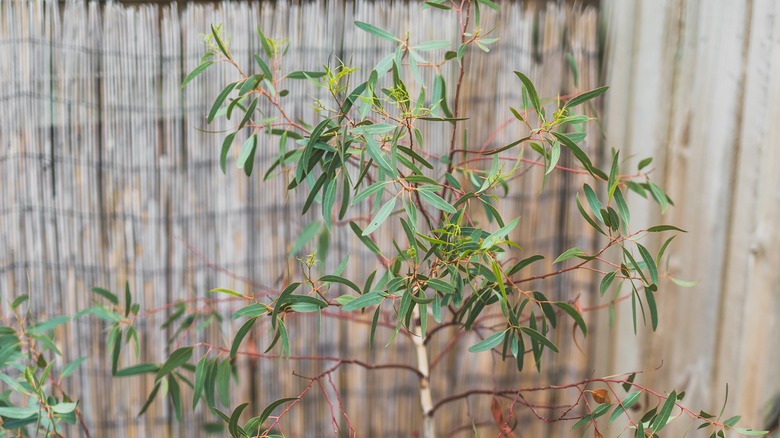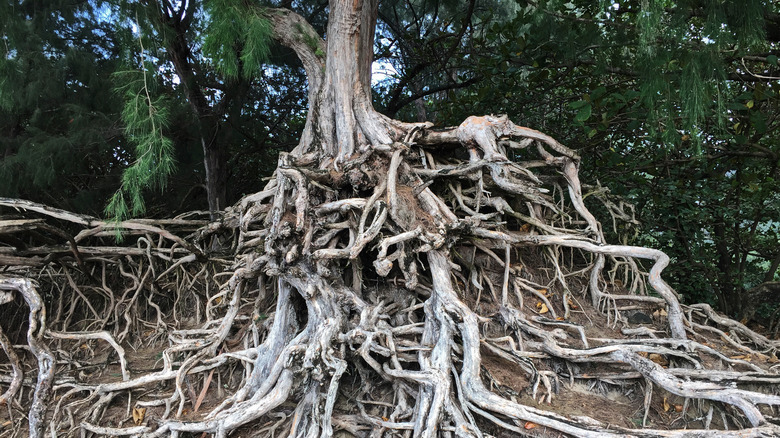Eucalyptus is a popular addition to any house, whether you hang sprigs in your shower to release calming aromatherapy or successfully grow a eucalyptus potted plant. They carry a soothing scent that is widely reported to reduce stress, and their silvery gray leaves add an interesting touch to a room’s aesthetic. However, if you’re thinking of adding a eucalyptus tree to your garden, you might want to think twice. While a potted plant or a vase of sprigs won’t give you any trouble, a plant rooted in the ground in your backyard is a whole different story. That’s because it is an invasive species, and it can wreak havoc on your yard if you’re not careful.
Eucalyptus trees were first brought to North America via Australia, and since they come from a warm climate, they can live in USDA Hardiness Zones 8 to 11 in the U.S. This encompasses the south, the southwest, California, and the westernmost parts of the pacific northwest. However, since they’re a nonnative species, they can pose a potential danger to the surrounding ecosystem. Here is why it might be best to avoid planting these in your backyard.
The downsides of planting eucalyptus trees in your backyard

Eucalyptus is a known invasive species, and once it starts growing, it’s known to compete with surrounding plant life for nutrients and resources. For example, it is known as an extremely thirsty plant, so if you have other trees, shrubs, or flowerbeds planted nearby, the tree will likely suck all the moisture out of the soil before its neighboring plants have their fill. In addition to that, these attractive trees are known to be shedders, where they shed their bark and leaves in large amounts, littering the ground. Not only does this require you to do more yardwork than you might have anticipated, but the shedding is another survival tactic the tree employs to fight competition. If you decide to leave the bark and leaves where they are for some time, the debris will release chemicals that will stunt the growth of neighboring plants.
These trees are also potentially dangerous to grow in areas of the country that are prone to wildfires, such as California. There are several reasons for this. First, their shedding bark acts as a type of tinder; second, their oily leaves are fuel for fires; and lastly, their wood is especially easy to catch fire and burn. Plus, wind can carry their burning bark up to a mile, spreading the fire and increasing risk.
Their invasive roots are another problem

Not only might these invasive trees greedily steal nutrients from surrounding plants in your garden, but their roots are another worry. Their invasive roots can grow up to a whopping 100 feet, and they’re in constant search for water for the thirsty tree. That means they can spread quite far through your yard, and if you plant the tree close enough to your home, it can eventually disturb your foundation. But your home’s structure isn’t the only thing you need to worry about. Since they like to spread, they can also grow around things like pipes and septic tanks and can uproot sidewalks and driveways. However, the tree’s roots won’t likely spread this far unless they sense a pool of water in the ground, such as a leaky pipe or pooling water around the foundation. But the risk is still there.
If you decide to plant the tree regardless of its risks, one way to contain the roots is by creating root barriers. This usually includes digging a trench around the tree to expose the roots, and then a thick, plastic barrier (such as the Root Barrier from Mainline Materials) is vertically placed into the trench. It acts like a puncture-proof shield to keep the roots contained in the defined space. It’s recommended that you hire a professional arborist to do this to ensure the tree stays unharmed and the barrier is applied correctly.



